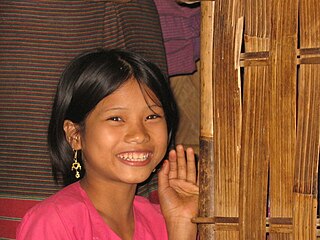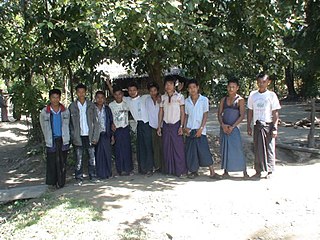
Mizoram is a state in northeastern India, with Aizawl as its capital city. The name is derived from "Mizo", the name of the native inhabitants, and "Ram", which means land, and thus Mizoram means "land of the Mizos". Within the northeast region, it is the southernmost landlocked state, sharing borders with three of the Seven Sister States, namely Tripura, Assam and Manipur. The state also shares a 722 kilometre border with the neighbouring countries of Bangladesh and Myanmar.
Hmar is the name of an ethnic group in the North Eastern States of India, western Burma and eastern Bangladesh. They speak some 40 languages, most of which are intelligible to one another and these languages again have many dialects. Khawsak language, popularly called Hmar ṭawng, has been adopted as the lingua franca and standard medium of communication

The Chin people are one of the major ethnic nationalities in Burma. The Chin are one of the founding groups of the Union of Burma. Chin is the primary ethnic group of the Chin State, who have many related languages, cultures and traditions. According to BBC News, "The Chin people... are one of the most persecuted minority groups in Burma." The largest ethnic group of the Chin people are the Zomi. These people predominantly live in the Chin State, Bago Division, Ayeyarwady Division, Magwe Division, Rakhine State and Sagaing Region of Myanmar, but are also spread throughout Burma, Bangladesh and India as refugee. In the 2014 Burmese ethnic census, the Chin ethnicity was again dismissed by the people of the Chin State.
The Mara people are the native inhabitants of Mizoram in India, native to northeastern India, primarily in the Mara Autonomous District Council of the state of Mizoram, where they form the majority of the population. The Maras are related to Kuki and Mizos in India and Kachin, Karen, Shan and Chins in Myanmar. Significant numbers of Maras are also found living south-western part of Chinland (Burma), in Myanmar - the contiguous area of Mara area in India mostly separated by Kolodyne river, which forms an international boundary. They were earlier known as the Lakher by outsiders as Mizo called them by that name and as Zo by the Lai and Shendu by the Rakhaing, and the new name Mara was inserted in List of Scheduled Tribes in Mizoram state in 1978 replacing the old name. The Maras were in early period known to the outside world under different tribal names such as Mara, Lakher, Shendu, Magha, Baungshel or Shendoo, Maring, Zyu or Zao/Zho, Khuangsai, etc. They constitute a distinct tribal group lying in Siaha / Saiha district of Mizoram. They called themselves "Maras". They are definitely a nation of tribes rather than just a tribe.

The history of Mizoram basically encompasses the history of Mizoram which lies in the remotest part of northeast India. It is a conglomerate history of several ethnic groups of Chin people who migrated from Chin State of Burma. But information of their patterns of westward migration are based on oral history and archaeological inferences, hence nothing definite can be said. The recorded history started relatively recently around the mid-19th century when the adjoining regions were occupied by the British monarchy. The land is now inhabited by a mixture of people from Chin Hills and Bangladesh and its history is therefore largely reflected by those of Lusei, Hmar, Lai, Mara and Chakmas tribes. Following religious, political and cultural revolutions in the mid-20th century majority of the people agglomerated into a super tribe, Mizo. Hence the officially recognised settlement of the Mizos became Mizoram.

The Kukis constitute one of several hill tribes within India, Bangladesh, and Burma. As Chin in the Chin State of Myanmar and as Mizo in the State of Mizoram in India are a number of related Tibeto-Burman tribal peoples spread throughout the northeastern states of India, northwestern Burma, and the Chittagong Hill Tracts of Bangladesh. In Northeast India, they are present in all states except Arunachal Pradesh. This dispersal across international borders is a culmination of punitive actions made by the British during their occupation of India.

The Mizo language, or Mizo ṭawng, is a language belonging to the Sino-Tibetan family of languages, spoken natively by the Mizo people in the Mizoram state of India and Chin State in Burma. The language is also known as Lushai, a colonial term, as the Lusei people were the first among the Mizos to be encountered by the British in the course of their colonial expansion. Though still common, Lushai is considered incorrect by the Mizo themselves. The Mizo language is mainly based on Lusei language, locally known as Lusei ṭawng or Duhlian ṭawng but it also derives many words from its surrounding Mizo sub-tribes and sub-clan. Now, Mizo language or Mizo ṭawng is the lingua franca of Mizoram and its surrounding areas and to a lesser extent of Burma and Bangladesh and in India in some parts of Assam, Tripura and Manipur. Many poetic language is derived from Pawi, Paite, and Hmar, and most known ancient poems considered to be Lusei are actually in Pawi. Mizo is the official language of Mizoram, along with English, and there have been efforts to have it included in the Eighth Schedule to the Constitution of India.

The official and de facto national language of Bangladesh is Modern Standard Bengali. It serves as the lingua franca of the nation, with 98% of Bangladeshis fluent in Bengali as their first language. English, having no official status, is prevalent across government, law, business, media and education and can be regarded as the de facto co-official language of Bangladesh.

Zogam known as Zoland, Lushai Hills, Kuki Hills, lies in the northwest corner of the Mainland Southeast Asia landmass. This is the traditional homeland of the Zo people or Zomi who lived in this area before the colonial period under British rulership.
The Kuki-Chin languages are a branch of 50 or so Sino-Tibetan languages spoken in northeastern India, western Burma and eastern Bangladesh. Most speakers of these languages are known as Kukī in Assamese and as Chin in Burmese; some also identify as Lushei. Mizo is the most widely spoken of the Kuki-Chin languages.
The Chho are one of the eleven tribes of the Mizo people, native to Mindat and Kanpalet area in the Chin Hills of Myanmar. They are also known as Sho, Kx'ou, Cho and Yindu.

The Khumis, are a community inhabiting in the Chittagong Hill Tracts of Bangladesh. The Khumis are one of smallest ethnic groups in Bangladesh with a population of only 1214 according to the 1991 census, though there are another 120,000 across the border in Burma.

The Mru, also known as the Taung Mro, the Mrung, and the Mrucha, refer to the tribes who live in the border regions between Myanmar (Burma), Bangladesh, and India. The Mru are a sub-group of the Chin people, the majority of whom live in western Myanmar. They are also found in the southern Chin State and northern Rakhine State. In Bangladesh, they reside in the Chittagong Hills in southeast Bangladesh, primarily in Bandarban District and Rangamati Hill District. In India, they reside in West Bengal.
The Zo people or Zomi, also known as the Mizo, the Kuki, the Chin and a number of other names, are a large group of related Tibeto-Burman peoples spread throughout the northeastern states of India, northwestern Myanmar (Burma) and the Chittagong Hill Tracts of Bangladesh. In northeastern India, they are present in: Nagaland, Mizoram, Manipur and Assam. This dispersal across international borders resulted from a British colonial policy that drew borders on political grounds rather than ethnic ones.

The Daingnet people, also known as the Thetkama people are an ethnic group indigenous to northern Rakhine State, Myanmar. According to their own internal census in 1995 they numbered about 60,000. In 2011, the number is estimated to be around 80,000. From appearance they are indistinguishable from the Rakhine people; however, the Daingnet people have a distinct language and culture. Ethnically, they are closely related to the Chakma people of Bangladesh and Northeast India. The languages of the Daingnet and Chakma people are mutually intelligible. Daingnet people are one of 135 ethnic groups officially recognized by the Myanmar government as indigenous to Myanmar. Daingnets are one of the Tibeto-Burman tribes. Genetically they are closely related to the Tibetans, Burmans and Rakhines.
Edwin Rowlands was a Welsh Christian missionary in northeast India and Burma. He was a professional teacher, singer, composer, poet, translator and literary figure among the Mizo people. He was regarded as the most beloved of all British missionaries in Mizoram. He was more popularly known as Zosapthara. He made the mojor hymns in Mizo and Khumi which are still in use. He modified the original Mizo alphabet and his system became the standard in Mizo language. He created written language for Khumi people in Burma, and for Bhil people in Maharashtra. His literary works are the foundation of Mizo literature. He was the first administrator of education in Mizoram as Honorary Inspector of Schools. Despite objection from various corners he married Thangkungi, a Mizo girl.

Arakan is a historic coastal region in Southeast Asia. It borders faced the Bay of Bengal to its west, the Indian subcontinent to its north and Burma proper to its east. The Arakan Mountains isolated the region and made it accessible only by sea. The region now forms the Rakhine State in Myanmar.
Mizo Culture is the culture of the Mizo people. Mizo culture is rooted in the arts and ways of life of Mizo’s in India,Bangladesh and Myanmar













